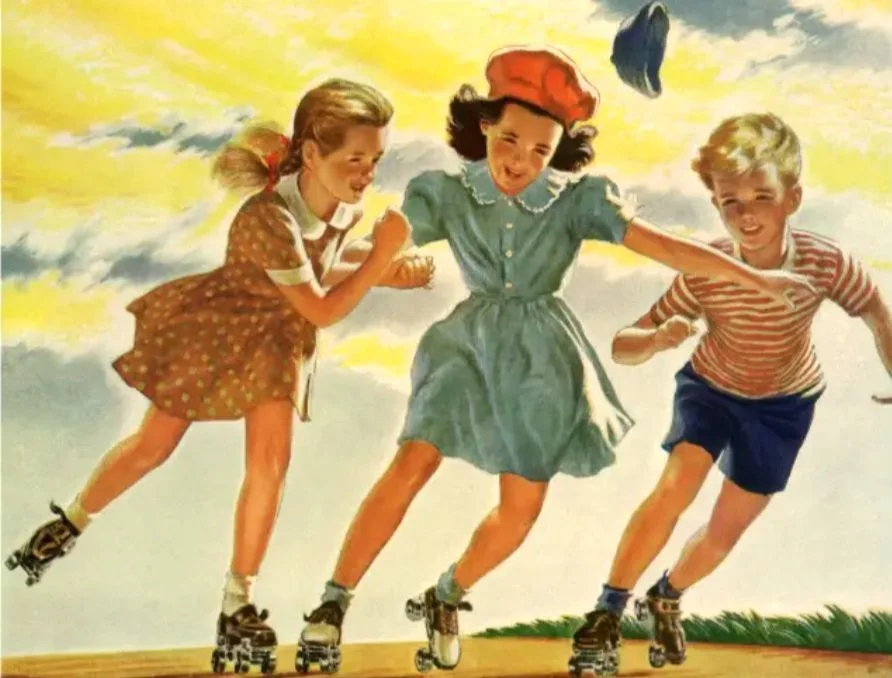In the late 1870s, Cape Cod embraced a new craze called roller skating, its popularity enhanced by inventions of two Massachusetts men. Before James Plimpton, most roller skates were clumsy, in-line skates with between two and six wheels on each foot, virtually ice skates with wheels. Plimpton designed skates that had two sets of two wheels, side-by side. Still called quad skates, a rubber cushion between the wheels and base allowed skating a curve just by leaning. E.H. Barney, also from our state, developed a clamp-on skate which fit directly on shoes.
The first roller rink in America opened in Newport, RI in 1866. There were no rinks here when skating arrived, so any place with a wooden floor was used. The Barnstable Patriot reported in February 1883, that “Roller Skating fever has struck Cape Cod in good earnest and there is hardly a village but has a rink.” Ads for roller skates began appearing in Cape papers. Hardly a week went by without a new skating place being mentioned; Hyannis’s rink was noted as a great place to watch. “It is fun to see some of our heavy men sit down, they do it so quickly.” Eureka Hall in South Yarmouth (later the Standish Theater), and the Lyceum in Yarmouth Port both were rinks. Early in March 1884, the Lyceum’s board of directors voted $150 to stock the hall with roller skates.
Early wheels made of boxwood damaged wooden floors though floors made of yellow birch and maple received less damage. Wheels improved by using North American maple and oak. Rubber wheels appeared as early as 1852, but wood remained the choice until the early 20th century. The invention of ball-bearings in 1884 made rolling easier and skates lighter. Shoe skates were introduced at the turn of the century, but clamp-on skates continued into the 1960s. Inline skates and plastic wheels were innovations of the 1960s.
An editorial in the Patriot in July 1883 noted the difficulty in learning to skate: “One of the most noticeable things in a skating rink is the strong attraction between the human body and the floor of the rink…. There are two positions in skating, the perpendicular and the horizontal.”
Both young and old contributed to large attendance at rinks. Papers reported on those who excelled. Horace White was prize skater in South Yarmouth, Gracie Crowell was the best skater at Doric Hall in Dennis and Ada Drew the best in Hyannis. Burt Rogers of South Harwich masqueraded as a female skater at the Greenland rink!
Not all approved of roller skating, or “rinking.” Roller skating was denounced as “evil and ruinous.” In 1885, the Massachusetts Legislature even considered regulations that would forbid females under 21 from skating after 5 p.m. and skaters must skate separately.
The fad crashed on the Cape around 1890, and many rinks turned to other endeavors. Tarred roads, coming into general use after World War I, helped roller skating with steel wheels to regain popularity. Towns had to pass bylaws to control the sport. In 1925, Barnstable made it illegal for roller skates to be on any roadway except while crossing a street on a crosswalk. Barnstable’s very next bylaw made it illegal to cling to a moving motor vehicle on any roadway while riding roller skates, bicycles, or sleds!
Mill Hill Dance Floor
Indoor roller skating made a comeback in the 1920s and Yarmouth’s Pavilion on Route 28, near the present site of DiParma’s Restaurant, was the spot to go. In November 1928, the Pavilion burned down. Two years later, Ernie Baker built the Rainbow Ballroom and Rollerdrome across the street where it offered big band dancing with Ernie Baker’s Rainbow Orchestra – Ernie’s moniker being “Shiver and shake with Ernie Bake!” The floor was made of rock maple and laid over springs to soften the fatigue on legs while dancing and roller skating.
The Great Depression furthered interest in roller skating as it was inexpensive. Popularity grew after World War II, but indoor skating lasted only into the 1950s. The Rollerdrome was sold and became a series of stores.
Skaters at the Rainbow Rollerdrome
She skated at the roller rink,
She sat down on the floor,
She didn’t say a single word –
She doesn’t skate no more.
Excerpted from an article written by Duncan Oliver.







